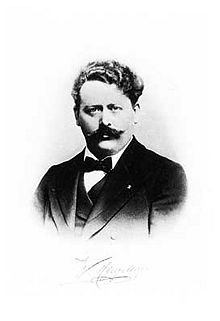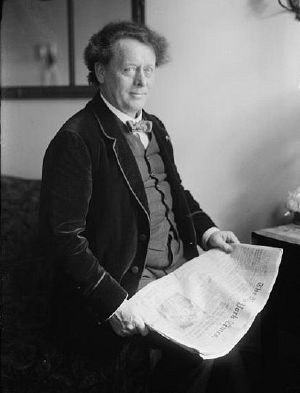Willem Mengelberg
| Willem Mengelberg | |
|---|---|
 | |
| Background information | |
| Birth name | Joseph Willem Mengelberg |
| Born | 28 March 1871 |
| Died | 21 March 1951 (aged 79) Zuort, Sent, Switzerland |
| Genre(s) | Classical |
| Occupation(s) | Composer,conductor, pedagogue |
| Years active | ca. 1890-1945 |
| Associated acts | Concertgebouw London Symphony New York Philharmonic |
Joseph Willem Mengelberg (28 March 1871 – 21 March 1951) was a Dutch conductor. He was the second of only six music directors of the renowned Royal Concertgebow Orchestra of Amsterdam, helping to develop it into one of the world’s most renown orchestras. His tenure with the Concertgebow lasted for 50 years from 1895 to 1945, one of the longest /orchestra relationships in music history. He also served as music director of the New York Philharmonic from 1922 to 1928.
Mengelberg was one of the first conductors outside of the Austro-Hungarian musical sphere to recognize the importance of the Gustav Mahler's compositions. Like several other European conductors of the era, his reputation suffered after WWII for his failure to speak out against the Nazis. He thus ended his career in exile after having been convicted of being a Nazi collaborator.
Biography
Early years and family
Mengelberg was born fourth of 16 children to German born parents in Utrecht, in the Netherlands. He studied in the Cologne conservatory, including piano and composition. At the age of 21, he was chosen as general music director of the city of Lucerne, Switzerland, where he was conductor of an orchestra and a choir, directed a music school, taught piano lessons and continued to compose.
Mengelberg's would include several prominent musicians and critics. He was the uncle of the musicologist and composer Rudolf Mengelberg and of the conductor, composer, and critic Karel Mengelberg, who was himself the father of the prominent improvising pianist and composer Misha Mengelberg.
Concertgebouw Orchestra
Mengelberg is most noted for his work as the principal conductor of the Concertgebouw Orchestra from 1895 to 1945. While there, Mengelberg founded the long-standing Mahler tradition of Concertgebouw. He toured widely with the orchestra and also became known as as a leading interpreter of Beethoven and Richard Strauss.
In 1902 Mengleberg had met Gustav Mahler and became friends with the composer. Mengelberg was instrumental in introducing most of Mahler's work to The Netherlands, and Mahler regularly visited the country to introduce his work to Dutch audiences. The composer also edited some of his symphonies while in Amsterdam, in order to make them sound better for the acoustics of the Concertgebouw. This concert hall and its orchestra would thus become renowned for its Mahler tradition. In 1920, Mengelberg conducted the Concertgebouw in the ten Mahler symphonies in a series of nine concerts as part of his his twenty-fifth anniversary season with the orchestra.
However, Mengelberg's importance as a conductor was not only due to his Mahler interpretations. He was also an exceptionally gifted performer of Richard Strauss, and even today his recordings of Strauss's tone poem Ein Heldenleben, which had been dedicated to him and the Concertgebouw Orchestra, are widely regarded by critics as among the best—if not the very best—of this piece ever produced.
On the other hand, one criticism of Mengelberg's influence over Dutch musical life, most clearly articulated by the composer Willem Pijper, was that Mengelberg did not particularly champion Dutch composers during his Concertgebouw tenure, especially after 1920.
===Other posts
While retaining his post with the Concertgebouw, Mengelberg was also frequent conductor of the London Symphony and the Royal Philharmonic Society from 1911–14. He was also music director of the New York Philharmonic Orchestra from 1922 to 1928.
In New York, Mengelberg made a series of recordings with the Philharmonic for both the Victor Talking Machine Company and Brunswick Records. One of his first recordings for Victor was a two-disc set devoted to A Victory Ball by Ernest Schelling. His 1928 recording of Strauss' Ein Heldenleben was later reissued on LP and compact disc.
Beginning in January 1926, he shared the podium in New York with Arturo Toscanini. The collaboration was not an entirely harmonious one, however. Toscanini's biographer, Harvey Sachs, has documented that Mengelberg and Toscanini clashed over interpretations of music and even rehearsal techniques, creating division among the musicians that eventually resulted in Mengelberg leaving the orchestra.
Mengelberg was also a frequent guest conductor with the London Symphony and the Royal Philharmonic Society from 1921–30.
Style
Mengelberg was considered a link to the conducting tradition of Wagner, Mahler and Furtwangler in that he believed that a significant aspect of the conductor's role was to impart a personal interpretation to a given piece of music. This view of his art is understood by his supposition that, "The performer must help the creator" and "faithfulness to the notes is a recent invention." This approach was antipodal to the literalists such as Arturo Toscanini, George Szell and others who moved away from the interpretive excesses of the Wagner/Furtwangler style.
It was not an uncommon practice for him to make alterations of scores (dynamics, instrumentation, etc.) which was thought by some to be sacrilege. He was also given to use rubato (fluctuations of tempo), and perhaps more than any other conductor he used portamento (gliding from one tone to the next) in the strings for expressive purposes. This is especially notable in his recordings of the Brahms symphonies.
In addition to being perhaps the foremost Mahler interpreters of his era, Mengelberg was a serious advocate and promoter of contemporary music and conducted many important world premiere performances including Béla Bartók's Concerto for Violin and Orchestra No. 2 (1939), Paul Hindemith's Der Schwanendreher (1935) and his Violin Concerto (1940), Zoltan Kodaly's Suite from Hary Janos (1927), Darius Milhaud's Carnaval d'Aix (1926) and Ottorino Respighi's Concerto in modo misolido (1924).
Controversy and exile
The most controversial aspect of Mengelberg's biography centers around his actions and behavior during the years of the Nazi occupation of Holland between 1940 and 1945. Some newspaper articles of the time gave the appearance that he acquiesced to the presence of the Nazi's ideological restrictions on particular composers. Explanations have ranged from political naiveté in general, to a general "blind spot" of criticism of anything German, given his own ancestry. Because of Mengelberg's co-operation with the occupying regime in The Netherlands during World War II, he was banned from conducting in the country by the Dutch government after the war in 1945. He was stripped of his honors and his passport.
The original judgment was that Mengelberg would be banned from conducting in the Netherlands for the remainder of his life. Appeals by his attorneys led to a reduction in the sentence to a banning of six years from conducting, retroactively applied to start from 1945. This notwithstanding, he continued to draw a pension from the orchestra until 1949 when cut off by the city council of Amsterdam. Mengelberg retreated in exile to Zuort, Sent, Switzerland, where he remained until his death in 1951, just two months before the expiration of his exile order.
Recorded Legacy
In addition to his acclaimed recordings of Richard Strauss' Ein Heldenleben, Mengelberg left valuable discs of symphonies by Beethoven and Brahms, not to mention a wildly controversial but gripping reading of Bach's St. Matthew Passion.
His most characteristic performances are marked by a tremendous expressiveness and freedom of tempo, perhaps most remarkable in his recording of Mahler's fourth Symphony but certainly present in the aforementioned St Matthew Passion and other performances as well. These qualities, shared (perhaps to a lesser extent) by only a handful of other conductors of the era of sound recording, such as Wilhelm Furtwängler and Leonard Bernstein, make much of his work unusually controversial among classical music listeners; recordings that more mainstream listeners consider unlistenable will be hailed by others as among the greatest recordings ever made.
Many of his recorded performances, including some live concerts in Amsterdam during World War II, have been reissued on LP and Compact Disc. While he was known for his recordings of the German repertoire, Capitol Records issued a powerful, nearly high fidelity recording of Cesar Franck's Symphony in D minor, recorded in the 1940s with the Concertgebouw Orchestra.
Due to the Dutch government's six-year ban on Mengelberg's conducting activities, he made no more recordings after 1945. Some of his performances in Amsterdam were recorded on the innovative German tape recorder, the Magnetophon, resulting in unusually high fidelity for the time.
Sound films of Mengelberg conducting the Concertgebouw Orchestra, during live concerts in Amsterdam, have survived. Among these are a 1931 performance of Karl Maria von Weber's Oberon overture and a 1939 performance of Bach's St. Matthew Passion.
Notes
ReferencesISBN links support NWE through referral fees
- Schonberg, Harold C., "The Great Conductors," Simon and Schuster, New York, 1967, ISBN 0-671207-350
- Lebrecht, Norman, "The Maestro Myth: Great Conductors in the Pursuit of Power," Carol Publishing Group, 1991, ISBN 1-559721-081
- Feder, Stuart, "Mahler: A Life in Crisis," Yale University Press, New Haven, 2004, ISBN 0-300103-409
External links
- Willem Mengelberg at the Bach Cantatas Website
- Listen to Mengelberg conduct and read his biography
- Discography
- The recording of Bach's St. Matthew Passion
- [1]
Credits
New World Encyclopedia writers and editors rewrote and completed the Wikipedia article in accordance with New World Encyclopedia standards. This article abides by terms of the Creative Commons CC-by-sa 3.0 License (CC-by-sa), which may be used and disseminated with proper attribution. Credit is due under the terms of this license that can reference both the New World Encyclopedia contributors and the selfless volunteer contributors of the Wikimedia Foundation. To cite this article click here for a list of acceptable citing formats.The history of earlier contributions by wikipedians is accessible to researchers here:
The history of this article since it was imported to New World Encyclopedia:
Note: Some restrictions may apply to use of individual images which are separately licensed.
